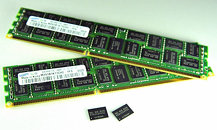Tuesday, July 21st 2009

Samsung First to Begin Mass Producing 2-Gigabit DDR3 Using 40nm Class Technology
Samsung Electronics Co., Ltd., the world leader in advanced memory technology, announced today that it has begun mass producing the industry's first two gigabit (Gb) DDR3 devices using 40 nanometer (nm) class process technology.
"We see market adoption to DDR3 picking up steam and are accommodating that with early entry of 2Gb DDR3 using the most efficient DRAM manufacturing technology available today," said Jim Elliott, Vice President, Memory Marketing, Samsung Semiconductor, Inc. "This will set the pace for a new standard in premium, eco-friendly DRAM solutions offering the most advanced, low power RDIMM for servers anywhere."Samsung's seven-month window between new process technology development and mass production of the new DDR3 (Jan. to Jul. '09) will allow OEMs to optimize their next-generation systems more quickly.
In addition, moving to a 40nm production process will provide around a 60 percent increase in production productivity over use of a 50 nm process.
Besides 16GB, 8GB and 4GB RDIMMs for servers, Samsung will produce UDIMMs (unregistered in-line memory modules) for work stations and desktop PCs or SODIMMs (small outline dual in-line memory modules) for notebook PCs of up to 4GBs, using the new chip.
The monolithic 2Gb chips are energy-efficient solutions for high-density, high-performance memory applications. Each supports a data rate of up to 1.6 gigabits per second (Gbps) at 1.35 volts, up to twice as fast as an 800Mbps 1Gb-based dual-die package.
According to market research firm iSuppli, 2 Gb DDR3 is expected to account for 82 percent of the total DDR3 DRAM market in units sold by 2012, and become the mainstream DDR3 DRAM product by 2010.
Source:
NewsWire Korea
"We see market adoption to DDR3 picking up steam and are accommodating that with early entry of 2Gb DDR3 using the most efficient DRAM manufacturing technology available today," said Jim Elliott, Vice President, Memory Marketing, Samsung Semiconductor, Inc. "This will set the pace for a new standard in premium, eco-friendly DRAM solutions offering the most advanced, low power RDIMM for servers anywhere."Samsung's seven-month window between new process technology development and mass production of the new DDR3 (Jan. to Jul. '09) will allow OEMs to optimize their next-generation systems more quickly.
In addition, moving to a 40nm production process will provide around a 60 percent increase in production productivity over use of a 50 nm process.
Besides 16GB, 8GB and 4GB RDIMMs for servers, Samsung will produce UDIMMs (unregistered in-line memory modules) for work stations and desktop PCs or SODIMMs (small outline dual in-line memory modules) for notebook PCs of up to 4GBs, using the new chip.
The monolithic 2Gb chips are energy-efficient solutions for high-density, high-performance memory applications. Each supports a data rate of up to 1.6 gigabits per second (Gbps) at 1.35 volts, up to twice as fast as an 800Mbps 1Gb-based dual-die package.
According to market research firm iSuppli, 2 Gb DDR3 is expected to account for 82 percent of the total DDR3 DRAM market in units sold by 2012, and become the mainstream DDR3 DRAM product by 2010.

10 Comments on Samsung First to Begin Mass Producing 2-Gigabit DDR3 Using 40nm Class Technology
Why not mention the speed in Mhz or something thats already how its speed is commonly measured??
4x6 = 24GB of system ram, on an i7.
This will bring the cost of DDR3 down because you can use less memory chips to make 2 and 4 GB sticks of RAM with only 1 or 2 of these. This means 2 very cool things.
1. RAM for laptops can now have a smaller form factor for the same density. Roughly half the size of current lappy ram sticks. This will lead to less heat, more space for better cooling of other parts, and more RAM in netbooks.
2. Stupid density for desktop RAM. 24 GB is small potatoes. Lets see. 2 GB a chip, 8 chips a side, 2 sides per stick (2 x 8 x 2 = 32 GB). That is 32 GB for 1 Stick of RAM. Lets image 64 GB dual channel sets, and 96 GB triple channel sets. :eek::rockout::respect:
soo can have bigger/cheaper/faster ram :)
It's 2 gigaBITs per chip which is like around 128 megabites